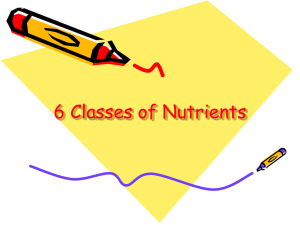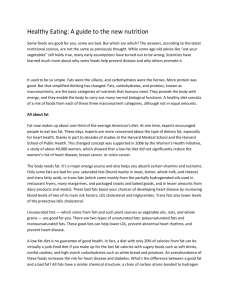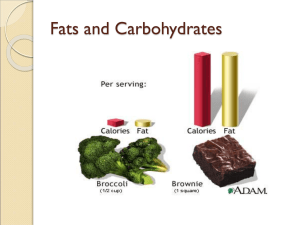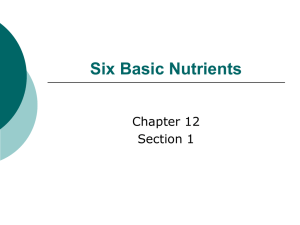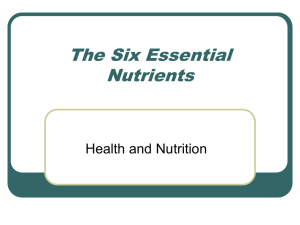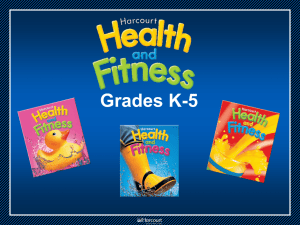Chapter 7: Nutrition for Life
advertisement
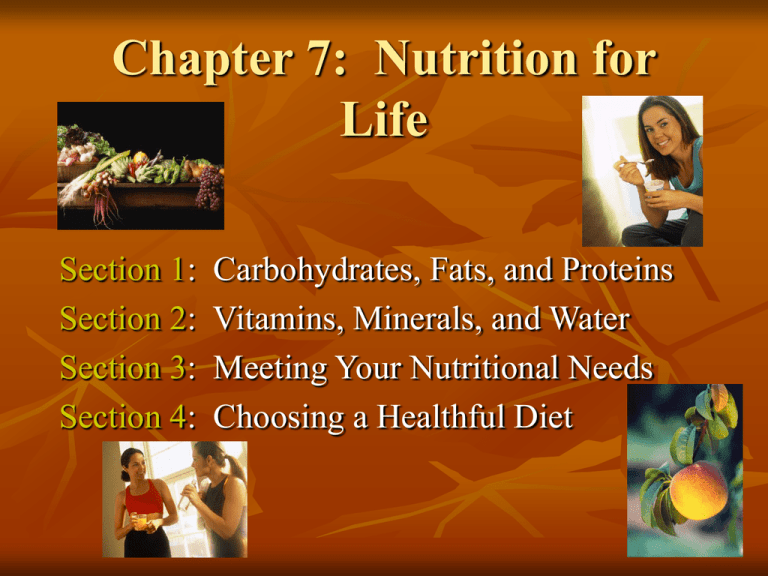
Chapter 7: Nutrition for Life Section 1: Section 2: Section 3: Section 4: Carbohydrates, Fats, and Proteins Vitamins, Minerals, and Water Meeting Your Nutritional Needs Choosing a Healthful Diet Section 1: Carbohydrates, Fats, and Proteins Nutrition “The science or study of _____.” The ways in which the _____ uses food . The study of how and why we make _____ choices. Nutrients “Substances in food that provide ______ or help form body tissues.” Are necessary for life and ______. Six Classes of Nutrients: There are six classes of nutrients in food: 1. 2. 3. 4. 5. 6. Carbohydrates Fats Proteins Vitamins Minerals Water To stay alive, healthy, and growing, a person must eat and drink the right amounts of ___________. Eating too little food causes ________ loss, poor _______, and if severe enough, death. Eating too _____ food can also cause illness What you eat today not only affect how you look and feel right now, it can affect your ________ in the future. Food = Fuel for Your Body _______ provides the fuel that runs your body. The _______ in food that provide energy are carbohydrates, fats, and proteins. The energy in food is measured in ________. The sum of the chemical processes that take place in your body to keep you alive and active is called _________. Food Energy and Calories The energy in food is measured in _________ (calories). A kilocalorie is “the amount of _______ needed to raise the temperature of 1 ____________ (a little more than 4 cups) of water 1 degree Celsius.” 1 gram of carbohydrate has ___ k/cal 1gram of protein has ___ k/cal 1 gram of fat has ___ k/cal Calories from Food A “balanced” diet of carbohydrate, protein and fat should consist of the following percentages of your total calories consumed each day: Note: These percentages are for teens. Carbohydrates: ______ % Fats: ______ % Protein: ______ % Carbohydrates – Two Basic Types “Sugars” - Simple Carbohydrates Made up of single or double sugar molecules Include: __________ – (blood sugar) single sugar molecule, the only form of sugar that the body can convert to usable energy __________- single sugar molecule, found naturally in fruit and honey ________ – (also called milk sugar), double sugar molecule, made by animals, found in dairy products _________ – (table sugar), double sugar molecule, found in candies “Starches” - Complex Carbohydrates Made up of larger sugar molecules, takes longer to be broken down and used by body Include: ________ – made of many glucose molecules linked together _________ – made in the body, made of many glucose molecules, stored in the muscles and livers of humans and animals, can be broken down to provide a quick source of glucose _______ – made of many glucose molecules, found in fruits and vegetables, cannot be digested by humans, needed for healthy digestive system “Sugars” – Simple Carbs Provides ________ for cells in the form of glucose All forms of sugar must be broken down into ________ before can be used by body for energy Some _______ naturally in foods (milk, fruits, vegetables) Some _______ are added to foods (candy, baked goods, cereals) ‘Starches” – Complex Carbs Type of _________ carbohydrate Made up of many sugar molecules hooked together. Eaten in food and broken down into simple sugars that can be used by _________. Most starches come from plant foods. __________ vegetables include potatoes, legumes (beans and peas) grains (rice, corn, wheat). Recommendation – 45-65 % of ca_________ in diet should come from carbohydrates. Most of calories should come from complex ______________. “Fiber” – Complex Carb Type of complex carbohydrate Provides little ________. Cannot be ________ by humans Absolutely necessary for digestion – keeps colon healthy by moving material through intestine preventing ______________. Helps prevent colon _______ and _______ disease Two Types of Fiber: ________ Fiber – dissolves in water, holds water in intestine increasing volume of material in ___________ tract, help protect you from heart disease by trapping bad _________ in food eaten (lowers blood cholesterol) Insoluble Fiber – adds _______ to body’s waste, found in hard or stringy part of ________, vegetables, and grains, found in whole grain breads, fruits, vegetables and legumes. Fats Essential ________ (our bodies need it to function properly) Fats add texture, _________, and aroma to food Eating too much ______ and eating the wrong kinds of fat can increase risk of weight gain, heart disease, and cancer Fats – also called “________” Fats are large molecules that are made up of two kind of smaller molecules – ________ and __________. Fat molecules are also called ___________ because three fatty acid molecules are one glycerol molecule Facts About Fat (Lipids) Fat us an essential nutrient. (We _______ it). Too little fat in or diet will lead to ____________ Too much fat in our _______ will lead to weight gain. Too much of the “bad” kind of fat can raise blood cholesterol levels Fat in our body provides ________ and _________ Dietary fat is needed to make regulatory ________ and coating on nerve cells Fats in foods add ________ and ________ and make us feel full. Types of Lipids Saturated Fats Made up of saturated fatty _________. Saturated fatty acids are large.__________ molecules that are bonded with many hydrogen atoms. Thus – the molecule is “saturated” with hydrogen atoms. Most saturated fats are _________ at room temperature. Most saturated fats come from _________ sources (meat, milk, ice cream, butter. Unsaturated Fats Made up of a chain of carbon atoms with one or more double bond between them. Molecules do not hold as many ________ atoms. Thus – the unsaturated fatty molecule is NOT saturated with hydrogen atoms. Unsaturated fats come from __________. Tend to be _______ at room temperature. Two Types of Unsaturated Fats Monounsaturated Fats Good fats – help lower risk of _________ disease. Found in _______ oil, canola oil, and peanut oil. Polyunsaturated Fats Fatty acids that contain more than ______ double bond. Examples – corn oil, sunflower oil, soybean oil. Omega-3 oil found in _____ and seafood is a polyunsaturated fat that can provide extra protection against heart disease. Dietary Fats and Lipids to Eat With Caution Transfats Unsaturated fats that are formed when ____________ oils are made into hard margarines. Increase the risk of heart disease Found in processed foods that go “___________.” Often labeled “______________ vegetable oils.” Cholesterol Necessary for certain body functions. Our _________ makes cholesterol Found only in _________ food sources – (meats, fish, poltry, milk and eggs), not in plants. Binds with low density lipoproteins (LDLs – bad cholestero) in our blood and stick to inside of arteries to form plaque. High density lipoproteins(HDL – good cholesterol) reduces risk of cholesterol, certain unsaturated fats can raise HDL levels in blood. Increases chances of __________ disease and __________. Proteins Your muscle, skin, hair, and nails are made up of mostly protein. Proteins in the body help _______ new cells and repair existing ones. Protein is needed to form ___________, enzymes and antibodies. Protein not used immediately as _______ will be stored as fat. Proteins are made up of molecule chains called _________ _______. ____ different amino acids in the body. ___ of the 22 cannot be made by the body. Two Types of Amino Acids Essential Amino Aids The nine of the 22 that cannot be made by the body are _________ to make body protein. Must be _______ in diet to meet body’s needs. Nonessential Amino Acids The 13 amino acids that can be made by the body combine with the essential amino acids that are in the foods we eat to ________. and form new body tissue (muscles, _______, nails). Types of Protein Complete Protein Protein foods in our diet that contains ALL of the essential amino acids. _________ proteins contain all of the essential amino acids. __________ plant sources will give you a complete protein. Examples of combining plant source foods to get a complete protein: Beans + grains = _______ protein Nuts + grains or vegetables = complete _________ Section 2: Vitamins, Minerals, and Water Vitamins A class of nutrients needed in _______ amounts to maintain health and allow growth. Vitamins are classified by whether they ________ in fat or water. This “_________” affects how the vitamins are taken into the body, used, stored, and eliminated. Fat-Soluble Vitamins Dissolved in fat. Stored in fat tissue in body. Remain in body for a long time. Vitamin / Foods That Have It Vitamin A – found in________, yellow and orange fruits and vegetables, dark-green leafy vegetables, eggs, cheese, butter. Vitamin D – found in _____ oils and fish, fortified milk, liver, egg yolk, produced in the body when skin is exposed to UV rays (________). What It Does Keeps _____ and skin healthy, needed for growth and for strong bones and teeth. Promotes absorption of __________ and phosphorus in the intestine, needed for strong bones and teeth. Fat-Soluble Vitamins - continued Vitamin / Foods That Have It __________ E – Vegetable oils, beans, peas, nuts, darkgreen vegetables, whole __________. Vitamin K – __________ vegetables (spinach, kale, broccoli) also produced in intestine by bacteria. What It Does _________ cell membranes from damage by connecting to “free radicals” in blood (extra oxygen atoms) that can cause damage to cells Aids in _______ clotting Water-Soluble Vitamins Not stored in body. Needed for release of energy from carbohydrates, fats and proteins. Vitamin / Foods that Have It B1, B2, B3, B5, B6, B12 – Various B vitamins found in __________, cereals, beans, meat, dairy products, eggs, green vegetables. Vitamin C- ________ fruits, melons, strawberries, green vegetables, peppers. What It Does Needed to produce _______ from foods eaten, for metabolism and other important body functions. Promotes healthy _____ and teeth, aids in wound healing, aids in iron absorption, acts as _____________ – protects body cells from damage. Minerals Needed for certain processes such as enzyme activity and ________ formation. More than 20 minerals are essential in small amounts to maintain good health. Taking a _______ and mineral supplement can prevent nutrient deficiency (not having enough of a nutrient to maintain good health. Best to _____ nutrient rich foods – rather than taking a __________. Calcium Chromium Copper Fluoride Iodine Iron Magnesium Potassium Phosphorus Selenium Sodium Sulfur Zinc Water Can only live a few days without water. Essential for almost all body functions. Extra water ________ be stored in body – must take in water as it leaves your body (sweat, urine, feces, breathing). Must take in at least 2.5 ______ per _____ to replace normal water loss. Can get water from foods. About _______% of weight of fruits and vegetables is water Caffeinated and alcoholic .beverages cause the body to excrete (lose) ______ water. Dehydration can cause thirst, headache, fatigue, loss of appetite, dry eyes and mouth, nausea, confusion and constipation. When you sweat you lose water weight (not fat).
